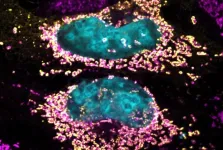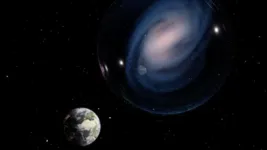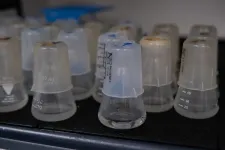(Press-News.org) Researchers at the University of São Paulo (USP) in Brazil, partnering with colleagues in Australia, have identified a novel bacterial protein that can keep human cells healthy even when the cells have a heavy bacterial burden. The discovery could lead to new treatments for a wide array of diseases relating to mitochondrial dysfunction, such as cancer and auto-immune disorders. Mitochondria are organelles that supply most of the chemical energy needed to power cells’ biochemical reactions.
An article on the study is published in the journal PNAS. The researchers analyzed more than 130 proteins released by Coxiella burnetii when this bacterium invades host cells, and found at least one to be capable of prolonging cell longevity by acting directly on mitochondria.
After invading host cells, C. burnetii releases a hitherto unknown protein, which the authors call mitochondrial coxiella effector F (MceF). MceF interacts with glutathione peroxidase 4 (GPX4), an anti-oxidant enzyme located in the mitochondria, to improve mitochondrial function by promoting an anti-oxidizing effect that averts cell damage and death, which may occur when pathogens replicate inside mammalian cells.
“C. burnetii uses various strategies to prevent the death of invaded cells and multiply inside them. One is modulation of GPX4 by MceF , the mechanism we discovered and reported in this article. Reallocation of these proteins in cellular mitochondria enables mammalian cells to live longer even when they’re infected with a very large bacterial burden,” said Dario Zamboni, one of the corresponding authors of the article and a professor at the Ribeirão Preto Medical School (FMRP-USP).
The study was conducted at the Center for Research on Inflammatory Diseases (CRID), one of FAPESP’s Research, Innovation and Dissemination Centers (RIDCs), in collaboration with Hayley Newton, a professor at Monash University in Australia. Funding was also provided by FAPESP via a project coordinated by Zamboni.
“Basically, we discovered a strategy used by C. burnetii to keep cells healthy for longer while replicating intensely. We found that its protein MceF redirects GPX4 to the mitochondria, where it acts as a potent anti-oxidant, detoxifying the infected cell and preventing cell components from aging, while allowing replication of the bacterium,” said Robson Kriiger Loterio, first author of the article, which derived from his PhD research.
Cell biologist
C. burnetii is the causative agent of a serious infection called Q fever, a relatively common but infrequently diagnosed zoonosis. According to the authors, agricultural outbreaks are “an increasingly significant economic and public health burden”.
The bacterium causes atypical pneumonia in humans and coxiellosis in some animals, such as cattle, sheep and goats. Zamboni explained that it is highly adapted to invade and control macrophages and monocytes – white blood cells that are part of the organism’s front-line immune defense – inhibiting the host’s responses to the infection.
“The interest of studying this bacterium in depth lies precisely in its ability to subvert cell functions. Unlike other bacteria, which cause disease only when they multiply to reach large numbers, a single C. burnetii is enough to make a healthy person sick. So it acts efficiently to modulate the cells it invades. We refer to it jokingly as a brilliant cell biologist because of this ability to modulate everything in host cells,” Zamboni said.
Another interesting aspect of C. burnetii, he added, is that it replicates in cells for about a week. For comparison, Salmonella, which causes severe food poisoning, causes the death of host cells in less than 24 hours.
“Observing C. burnetii is a good way to learn about how cells function. In the case of this study, it helped us understand how to treat mitochondrial dysfunction, and provided insights on programmed cell death in humans,” he said.
To analyze the bacterium’s capacity to subvert macrophages and act directly on mitochondria, the researchers conducted in vitro assays and experiments involving larvae of the Greater wax moth (Galleria mellonella). In this first stage of the study, they investigated more than 80 novel proteins from C. burnettii with the potential to interact with host cells and subvert their functioning. “We ended up focusing on MceF because it acts directly on mitochondria, which play a key role in the process of cell death,” Zamboni said.
The group will now continue the research on two fronts, one aiming at a deeper understanding of other proteins of interest, and the other involving biochemical studies to find out more about how MceF influences GPX4.
“The nice thing about this research is that by investigating a bacterium we’re learning a lot about cell signaling, cell death and novel ways of reversing mitochondrial dysfunction. We don’t need to invent a new technique. The process already occurs during the bacterium’s interaction with host cells,” he said.
About São Paulo Research Foundation (FAPESP)
The São Paulo Research Foundation (FAPESP) is a public institution with the mission of supporting scientific research in all fields of knowledge by awarding scholarships, fellowships and grants to investigators linked with higher education and research institutions in the State of São Paulo, Brazil. FAPESP is aware that the very best research can only be done by working with the best researchers internationally. Therefore, it has established partnerships with funding agencies, higher education, private companies, and research organizations in other countries known for the quality of their research and has been encouraging scientists funded by its grants to further develop their international collaboration. You can learn more about FAPESP at www.fapesp.br/en and visit FAPESP news agency at www.agencia.fapesp.br/en to keep updated with the latest scientific breakthroughs FAPESP helps achieve through its many programs, awards and research centers. You may also subscribe to FAPESP news agency at http://agencia.fapesp.br/subscribe.
END
Study reveals bacterial protein capable of keeping human cells healthy
Researchers describes a hitherto unknown protein with anti-oxidizing properties secreted by Coxiella burnetii, a Gram-negative intracellular bacterium, pointing to possible treatments for auto-immune diseases and even cancer
2023-11-09
ELSE PRESS RELEASES FROM THIS DATE:
Endangered thick-billed parrots at risk of losing newly identified, unprotected Sierra Madre forest habitats to logging, deforestation, study shows
2023-11-09
DOWNLOAD PHOTOS AND VIDEO: https://sandiegozoo.box.com/s/x50kzaoukdtyjxsv9mzqgn0fu1m6kddk
A binational team of scientists, using creativity and innovation, adorned dozens of endangered thick-billed parrots with tiny solar-powered satellite transmitters to track and reveal their winter migratory nesting sites in the remote treetops of the Sierra Madre Occidental ranges. Their research reveals new critical habitat, 80% of which has no formal protection.
In a study published this month in the journal Global ...
Atomic dance gives rise to a magnet
2023-11-09
Quantum materials hold the key to a future of lightning-speed, energy-efficient information systems. The problem with tapping their transformative potential is that, in solids, the vast number of atoms often drowns out the exotic quantum properties electrons carry.
Rice University researchers in the lab of quantum materials scientist Hanyu Zhu found that when they move in circles, atoms can also work wonders: When the atomic lattice in a rare-earth crystal becomes animated with a corkscrew-shaped vibration known as a chiral phonon, the crystal is transformed ...
Milky Way-like galaxy found in the early universe
2023-11-09
Using the James Webb Space Telescope, an international team, including astronomer Alexander de la Vega of the University of California, Riverside, has discovered the most distant barred spiral galaxy similar to the Milky Way that has been observed to date.
Until now it was believed that barred spiral galaxies like the Milky Way could not be observed before the universe, estimated to be 13.8 billion years old, reached half of its current age.
The research, published in Nature this week, was led by scientists at the Centro de Astrobiología in Spain.
“This galaxy, named ceers-2112, formed soon after ...
Side-effect avoiding treatment shows early promise against breast cancer in mice
2023-11-09
New experimental evidence suggests that substances known as narrow-spectrum Wnt signaling inhibitors—which could have fewer side effects than other related substances—are capable of suppressing the growth of breast cancer tumors in mice. Aina He of Shanghai Jiaotong University Affiliated Sixth People’s Hospital, China, and colleagues present these findings November 9th in the open access journal PLOS Biology.
While certain subtypes of breast cancer can be targeted with special medications, others can only be treated with standard chemotherapy. For some patients, chemotherapy may lead to the growth of stem cell-like cancer cells that are drug resistant. Previous ...
Bacteria-virus arms race provides rare window into rapid and complex evolution
2023-11-09
As conceived by Charles Darwin in the 1800s, evolution is a slow, gradual process during which species adaptations are inherited incrementally over generations. However, today biologists can see how evolutionary changes unfold on much more accelerated timescales.
Rather than the evocative plants and animals of the Galapagos Islands that Darwin studied in forming his theory of evolution, Postdoctoral Scholar Joshua Borin and Associate Professor Justin Meyer of UC San Diego’s School of Biological Sciences are documenting rapid evolutionary processes in simple laboratory flasks.
Borin ...
Open-science “COVID Moonshot” discovers new antivirals to treat COVID-19
2023-11-09
Although the group’s work has been freely available since its inception in March 2020, the COVID Moonshot Consortium is finally formally reporting their results. The COVID Moonshot – an open-science, crowdsourced, and patent-free drug discovery campaign targeting the SARS-CoV-2 virus – has yielded a wealth of data on the virus’s main protease, including insights that could pave the way for the development of new and better therapeutics. “The lead therapeutics described by [these researchers] may not be ready in time to affect the current pandemic, considering the timelines and challenges of drug approval,” write Brian Shoichet and Charles ...
Shrinking a mode-locked laser to the size of an optical chip
2023-11-09
Setting out to improve a technology that usually requires bulky, bench-top equipment, Quishi Guo and colleagues have shrunk a mode-locked laser (MLL) to the size of an optical chip with an integrated nanophotonic platform. The results show promise for developing ultrafast nanophotonic systems for a wide range of applications. Mode-locked lasers (MLLs) can produce coherent ultrashort pulses of light at extremely fast speeds – on the order of picoseconds and femtoseconds. These devices have enabled numerous technologies in photonics, including extreme nonlinear optics, two-photon microscopy, ...
Wildfire risk to US homes is rising, especially in western grasslands and shrublands
2023-11-09
Drawing on 30 years of data, researchers show that the number of homes within wildfire perimeters in the U.S. has doubled since the 1990s. This increasing risk is driven by both an increase in wildfires and the expansion of new homes into wildfire-prone areas, especially in the wildland-urban interface. Wildfire risks to homes are increasing, particularly in the wildland-urban interface (WUI), where houses and wildland vegetation are in close proximity. Over the last 12 years, more than 55,000 homes in the U.S. have been lost to wildfires due to rapid increases ...
Introducing: Ceramic- and glass-based passive radiative cooling materials resistance to harsh environments
2023-11-09
Two studies highlight new glass- and ceramic-based passive radiative cooling materials. Unlike passive radiative cooling approaches that rely on polymers, these hard materials are more durable and versatile, making them more attractive for a wide range of outdoor passive cooling applications, including those that could help reduce the need for air conditioning. The energy demand for cooling continues to rise, particularly in regions rapidly warming due to climate change. To make matters worse, the growing carbon footprint of cooling systems further contributes to global warming, exacerbating the need for cooling solutions. Passive radiative cooling (PRC) materials, which ...
Researchers identify previously unknown step in cholesterol absorption in the gut
2023-11-09
UCLA researchers have described a previously unknown step in the complex process by which dietary cholesterol is processed in the intestines before being released into the bloodstream – potentially revealing a new pathway to target in cholesterol treatment.
Although an existing drug and statins impact part of the process, an experimental drug being studied in UCLA research labs appears to specifically target the newfound pathway, possibly adding a new approach to the cholesterol management toolbox.
“Our results show that certain proteins in the Aster family play a critical role in moving cholesterol through the absorption and uptake process,” said ...
LAST 30 PRESS RELEASES:
Why nail-biting, procrastination and other self-sabotaging behaviors are rooted in survival instincts
Regional variations in mechanical properties of porcine leptomeninges
Artificial empathy in therapy and healthcare: advancements in interpersonal interaction technologies
Why some brains switch gears more efficiently than others
UVA’s Jundong Li wins ICDM’S 2025 Tao Li Award for data mining, machine learning
UVA’s low-power, high-performance computer power player Mircea Stan earns National Academy of Inventors fellowship
Not playing by the rules: USU researcher explores filamentous algae dynamics in rivers
Do our body clocks influence our risk of dementia?
Anthropologists offer new evidence of bipedalism in long-debated fossil discovery
Safer receipt paper from wood
Dosage-sensitive genes suggest no whole-genome duplications in ancestral angiosperm
First ancient human herpesvirus genomes document their deep history with humans
Why Some Bacteria Survive Antibiotics and How to Stop Them - New study reveals that bacteria can survive antibiotic treatment through two fundamentally different “shutdown modes”
UCLA study links scar healing to dangerous placenta condition
CHANGE-seq-BE finds off-target changes in the genome from base editors
The Journal of Nuclear Medicine Ahead-of-Print Tip Sheet: January 2, 2026
Delayed or absent first dose of measles, mumps, and rubella vaccination
Trends in US preterm birth rates by household income and race and ethnicity
Study identifies potential biomarker linked to progression and brain inflammation in multiple sclerosis
Many mothers in Norway do not show up for postnatal check-ups
Researchers want to find out why quick clay is so unstable
Superradiant spins show teamwork at the quantum scale
Cleveland Clinic Research links tumor bacteria to immunotherapy resistance in head and neck cancer
First Editorial of 2026: Resisting AI slop
Joint ground- and space-based observations reveal Saturn-mass rogue planet
Inheritable genetic variant offers protection against blood cancer risk and progression
Pigs settled Pacific islands alongside early human voyagers
A Coral reef’s daily pulse reshapes microbes in surrounding waters
EAST Tokamak experiments exceed plasma density limit, offering new approach to fusion ignition
Groundbreaking discovery reveals Africa’s oldest cremation pyre and complex ritual practices
[Press-News.org] Study reveals bacterial protein capable of keeping human cells healthyResearchers describes a hitherto unknown protein with anti-oxidizing properties secreted by Coxiella burnetii, a Gram-negative intracellular bacterium, pointing to possible treatments for auto-immune diseases and even cancer




